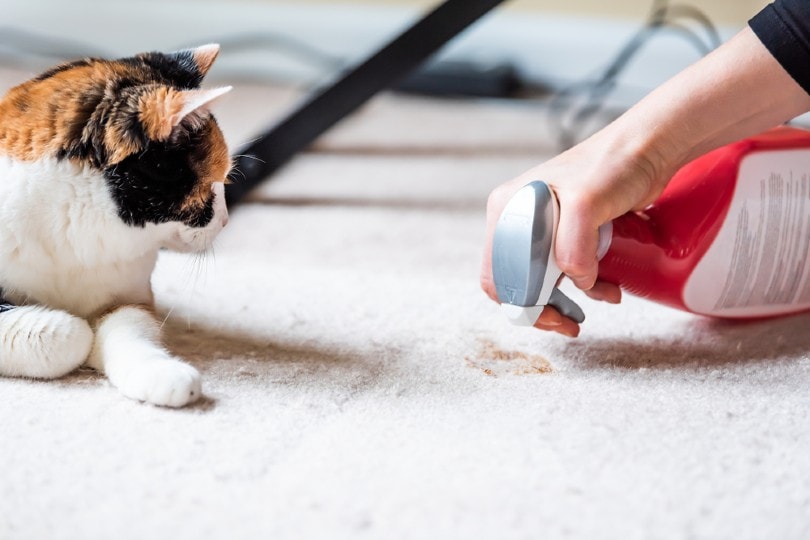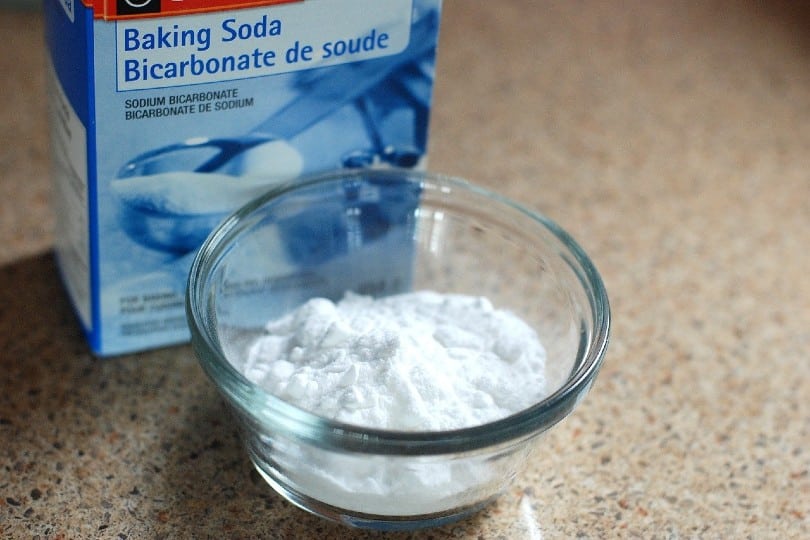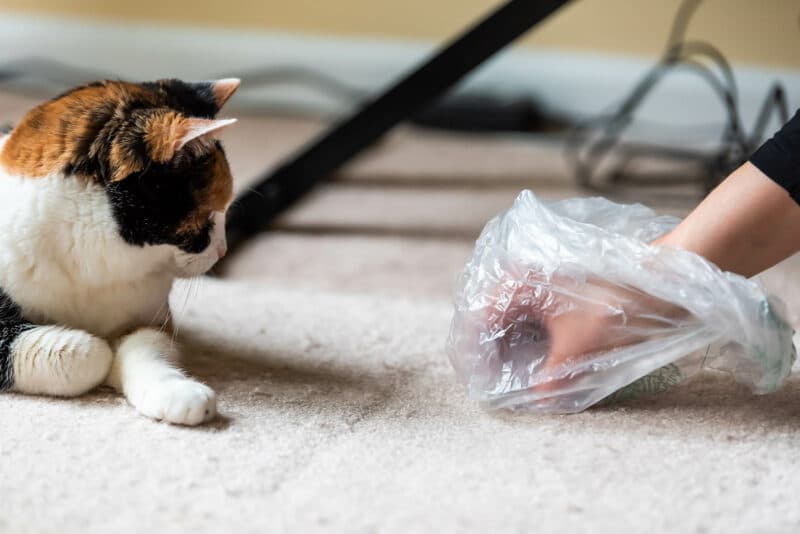Although cats groom themselves thoroughly and typically don’t miss the litter box, accidents happen occasionally. Cat feces can sometimes be tricky to get out, especially if it has dried. If you need a solution, the good news is that it’s not too difficult and you probably already have all the necessary supplies.
However, if it’s occurred repeatedly in the same spot, you might need a booster to eliminate the smell. We will go over an inexpensive cleaning method to remove the stain. If you need extra help, we’ll discuss how to remove advanced stains, too. Let’s get down to it.
How To Get Rid of Cat Poop Smell in Carpet in 12 Steps
1. Get Your Supplies
- Rubber gloves
- Paper towels or rags
- A plastic bag or waste bin
- A premixed solution of dish soap and white vinegar
- Vacuum
- Baking soda
2. Try Not to Let it Dry on the Carpet
Put on your gloves before removing the waste. Cat poop has toxins that can make you sick if you accidentally ingest it. Once you have all of your supplies ready and your gloves on—you’re good to go!
Try to get to it before it air dries (if you can). The longer the poop sets, the harder it is to remove. The quicker you find it, the more likely you’ll get most of the waste out by picking it up. Getting dried poop out of the carpet can be a little more challenging but still manageable.

3. Get Out as Much as Possible
Take a cloth or paper towel and pick out as much of the solid matter as possible. The more it’s ground into the carpet, the harder it is to remove. If you leave remnants, your cat can still smell that they’ve used this spot before. A repeat offense is much more likely.
4. Make a Simple, But Effective Concoction
You can make a simple solution with products you always have around. Use dish soap with no added bleach and a tablespoon of white vinegar. Place the mixture into a spray bottle or bowl.
Try not to use any products with bleach. Bleach could stain your carpet, so you won’t want to risk a color change to the area. Also, bleach doesn’t get rid of cat odors.

5. Add the Solution to the Stain
You should gently pour, spray, or dab the solution over the spot, but try not to get any outside of the affected area. Let the solution settle into the spoiled spot for a few minutes so that it can loosen the poop.
6. Blot the Area
Blot up as much of the liquid as you can. You should see the remaining poop lift from the carpet.

7. Repeat Until the Carpet is Clean
Keep adding solution and blotting until your paper towel or rag is clear. No residue or matter should be left if the carpet is truly clean.
8. Rinse with Water
Once you’ve successfully removed the poop, rinse the area lightly with plain tap water to get the concoction out of the carpet. Blot the area once more with a dry cloth or paper towel.

9. Wait for the Area to Dry
Leave the area alone until it dries up. You can even speed up the process by taking a blow dryer to the wet portion.
10. Sprinkle Baking Soda on the Spot
Baking soda is a great neutralizer. Sprinkle baking soda on the spot and allow it to sit for approximately 1 hour.

11. Vacuum
With a few passes, the vacuum will take up the existing baking soda. The area should be odor and debris-free.
12. Use an Odor-Blocking Scent Product (Optional)
You can sprinkle or spray your carpet with fragrance or essential oil spray to make the room smell good. However, keep your cat out of the room until the fragrance dissipates; some essential oils are harmful to cats.

Products for Difficult Odor
If your cat is making a habit of using your floor as a litter box, you might run into some residual odors. The good news is that they have products on the market that are specifically formulated to remove tough pet smells, including feces.
Did you know there's an enzyme cleaner that does it all? The Hepper Advanced Bio-Enzyme Pet Stain & Odor Eliminator Spray permanently removes the very worst smells and stains (truly, everything you can imagine!), and they offer a 100% satisfaction guarantee! Click here to get yourself a bottle.
- ADVANCED ENZYMATIC CLEANER - Penetrates the most stubborn smells and stains at the deepest molecular...
- FOR ANY MESS, ON ANY SURFACE - This pet odor eliminator cleans your carpets, floors, furniture,...
- FRESH, NATURAL ODOR - Our unique formulation doesn't rely on dangerous or unpleasant chemical...
At Catster, we’ve admired Hepper for many years, and decided to take a controlling ownership interest so that we could benefit from the outstanding products of this cool cat company!
- Pet Odor Candles — Who doesn’t love a candle that will fill your home with lovely aromas instead of cat poop smells?
- Diffusers — They contain formulas that deter cats from going to the bathroom outside of their litter box.
- Absorbing Gel — These gels attract and trap odors to eliminate smells in the air.
- Solutions — Many spray solutions remove the odors you might not smell, but your cat can. This prevents future offenses to your carpet and other household surfaces.
Final Thoughts: How to Get Poop Smell Out of Carpet
Cleaning up cat poop room on the carpet isn’t a task anyone wants to do, but accidents happen. Try to remove the poop before using a cleaner. If this is an ongoing issue, contact your vet. The issue may be related to a behavioral or physical issue.
Endless pet products are available that remove pet odors from carpet. Shop around to see if you find the miracle product you’re looking for.
See also:
- Why Is My Cat’s Poop Watery? 8 Vet-Approved Reasons
- 11 Ways to Make a Constipated Kitten Poop (Vet Answer)
Featured image credit: Kristi Blokhin, Shutterstock
Contents
- How To Get Rid of Cat Poop Smell in Carpet in 12 Steps
- 1. Get Your Supplies
- 2. Try Not to Let it Dry on the Carpet
- 3. Get Out as Much as Possible
- 4. Make a Simple, But Effective Concoction
- 5. Add the Solution to the Stain
- 6. Blot the Area
- 7. Repeat Until the Carpet is Clean
- 8. Rinse with Water
- 9. Wait for the Area to Dry
- 10. Sprinkle Baking Soda on the Spot
- 11. Vacuum
- 12. Use an Odor-Blocking Scent Product (Optional)
- Products for Difficult Odor
- Final Thoughts: How to Get Poop Smell Out of Carpet












